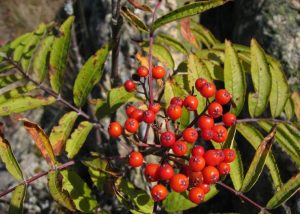American Mountain Ash Phenophase Definitions
Directions: As you report on phenophase status (Y, N or ?) on the datasheets, refer to the definitions on this sheet to find out what you should look for, for each phenophase in each species. To report the intensity of the phenophase, choose the best answer to the question below the phenophase, if one is included.
Leaves
Breaking leaf buds: One or more breaking leaf buds are visible on the plant. A leaf bud is considered “breaking” once a green leaf tip is visible at the end of the bud, but before the first leaf from the bud has unfolded to expose the leaf stalk (petiole) or leaf base.
How many buds are breaking?
Less than 3; 3 to 10; More than 10.

Leaves: One or more live unfolded leaves are visible on the plant. A leaf is considered “unfolded” once the leaf stalk (petiole) or leaf base is visible. New small leaves may need to be bent backwards to see whether the leaf stalk or leaf base is visible. Do not include dried or dead leaves.
What proportion of the canopy is full with leaves?
Less than 5%; 5-24%; 25-49%; 50-74%; 75-94%; 95% or more.
Increasing leaf size: A majority of leaves on the plant have not yet reached their full size and are still growing larger. Do not include new leaves that continue to emerge at the ends of elongating stems throughout the growing season.
What proportion of full size are most leaves?
Less than 25%; 25-49%; 50-74%; 75-94%; 95% or more.
Colored leaves: One or more leaves (including any that have recently fallen from the plant) have turned to their late-season colors.
What proportion of the canopy is still full with green leaves?
95% or more; 75-94%; 50-74%; 25-49%; 5-24%; Less than 5%.
Falling leaves: One or more leaves are falling or have recently fallen from the plant.
Flowers
Flowers or Flower Buds: One or more fresh open or unopened flowers or flower buds are visible on the plant. Include flower buds that are still developing, but do not include wilted or dried flowers. For species in which individual flowers are clustered in flower heads, spikes or catkins (inflorescences), simply estimate the number of flower heads, spikes or catkins and not the number of individual flowers.
How many fresh flowers or flower buds are present?
Less than 3; 3 to 10; More than 10.

Open flowers: One or more open fresh flowers are visible on the plant. Flowers are considered “open” when the reproductive parts (male stamens or female pistils) are visible between unfolded or open flower parts. Do not include wilted or dried flowers that remain on the plant. For species in which individual flowers are clustered in flower heads, spikes or catkins (inflorescences), estimate the percentage of all individual flowers that are open.
How many fresh flowers are open?
Less than 5%; 5-24%; 25-49%; 50-74%; 75-94%; 95% or more
Fruits
Fruits: One or more fresh fruits are visible on the plant. For Sorbus americana, the fruit is berry-like and changes from green to yellow-orange to orange-red or bright red.
How many fresh fruits are present?
Less than 3; 3 to 10; More than 10.

Ripe fruits: One or more ripe fruits are visible on the plant. For Sorbus americana, a fruit is considered ripe when it has turned orange-red or bright red.
How many fruits are ripe?
Less than 3; 3 to 10; More than 10.
Recent fruit drop: One or more fresh mature fruits or seeds have dropped or been removed from the plant since your last visit. Do not include obviously immature fruits that have dropped before ripening, such as in a heavy rain or wind.
How many mature fruits have dropped?
Less than 3; 3 to 10; More than 10.
Special Considerations for Observing Deciduous Trees and Shrubs
If drought seems to be the cause of leaf color or fall for a plant, please make a comment about it for that observation.
